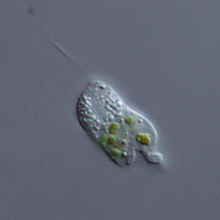- Cercozoa
-
Cercozoa 
Cercomonas Scientific classification Domain: Eukaryota Kingdom: Rhizaria Phylum: Cercozoa
Cavalier-Smith 1998[1]The Cercozoa are a group of protists. They are sometimes described as a kingdom.[2]
Contents
Characteristics
The group includes most amoeboids and flagellates that feed by means of filose pseudopods. These may be restricted to part of the cell surface, but there is never a true cytostome or mouth as found in many other protozoa. They show a variety of forms[3] and have proven difficult to define in terms of structural characteristics, although their unity is strongly supported by genetic studies. Cercozoa are closely related to Foraminifera and Radiolaria, amoeboids that usually have complex shells, and together with them form a supergroup called the Rhizaria.
Types
They are sometimes grouped by whether they are "filose" or "reticulose".[4]
Filose (subphylum Filosa)
The best-known Cercozoa are the euglyphids, filose amoebae with shells of siliceous scales or plates, which are commonly found in soils, nutrient-rich waters, and on aquatic plants. Some other filose amoebae produce organic shells, including the tectofilosids and Gromia. They were formerly classified with the euglyphids as the Testaceafilosia. This group is not monophyletic, but nearly all studied members fall in or near the Cercozoa, related to similarly shelled flagellates.
Reticulose (subphylum Endomyxa)
Another important group placed here are the chlorarachniophytes, strange amoebae that form a reticulating net. They are set apart by the presence of chloroplasts, which apparently developed from an ingested green alga. They are bound by four membranes and still possess a vestigial nucleus, called a nucleomorph. As such, they have been of great interest to researchers studying the endosymbiotic origins of organelles.
Chlorarachniophytes are sometimes considered Filosa, rather than Endomyxa, while groups such as Gromia are considered Endomyxa.[5]
Ungrouped
Other notable cercozoans include the cercomonads, which are common soil flagellates, and the Phaeodarea, marine protozoa that were previously considered radiolarians. In addition, three groups that are traditionally considered heliozoans belong here: the Heliomonadida, Desmothoracida, and Gymnosphaerida.
Classification
The exact composition and classification of the Cercozoa are still being worked out. A general scheme is:
Class Chlorarachnea Chlorarachniophyta Class Proteomyxidea Gymnophryida, Heliomonadida, Desmothoracida, Gymnosphaerida, etc. Class Sarcomonadea Cercomonadida Class Imbricatea / Silicofilosea Euglyphida and Thaumatomonadida Class Thecofilosea Tectofilosida and Cryomonadida Class Phaeodarea Class Ebridea Ebridea In addition two groups of parasites, the Phytomyxea and Ascetosporea, and the shelled amoeba Gromia may be basal Cercozoa, although some trees place them closer to the Foraminifera.
The spongomonads have been included here, but more recently have been considered Amoebozoa.[citation needed]
Some other small groups of protozoans are considered Cercozoa but are of uncertain placement, and it is likely many obscure genera will turn out to be cercozoans with further study.
References
- ^ Cavalier-Smith, T. (1998). "A revised six-kingdom system of life". Biological Reviews of the Cambridge Philosophical Society 73 (3): 203–266. doi:10.1111/j.1469-185X.1998.tb00030.x. PMID 9809012.
- ^ "CERCOZOAE". http://comenius.susqu.edu/bi/202/RHIZARIA/CERCOZOAE/default.htm. Retrieved 2009-03-28.
- ^ Cavalier-Smith T, Chao EE (October 2003). "Phylogeny and classification of phylum Cercozoa (Protozoa)". Protist 154 (3–4): 341–58. doi:10.1078/143446103322454112. PMID 14658494.
- ^ Bass D, Chao EE, Nikolaev S, et al. (February 2009). "Phylogeny of Novel Naked Filose and Reticulose Cercozoa: Granofilosea cl. n. and Proteomyxidea Revised". Protist 160 (1): 75–109. doi:10.1016/j.protis.2008.07.002. PMID 18952499. http://linkinghub.elsevier.com/retrieve/pii/S1434-4610(08)00044-8.
- ^ "Cercozoa". http://tolweb.org/Cercozoa. Retrieved 2009-05-21.
External links
- Tree of Life Cercozoa
Eukaryota Bikonta AH/SARAHSARHalvariaHeterokont ("S")Unikonta Apusomonadida (Apusomonas, Amastigomonas) · Ancyromonadida (Ancyromonas) · Hemimastigida (Hemimastix, Spironema, Stereonema)HolozoaDermocystida · IchthyophonidaFilozoaFilastereaCapsaspora · MinisteriaChoanoflagellateaRhizaria Cercozoa FilosaImbricateaEuglyphida: Cyphoderiidae · Euglyphidae · Paulinellidae · Trinematidae · Thaumatomonadida: ThaumatomastigidaeThecofiloseaSpongomonadeaSpongomonas, RhipidodendronCercomonadidae · Heteromitidae · SainouridaeReticulofilosaProteomyxideaGymnophryidae · Heliomorphidae · Desmothoracida · GymnosphaeridaChlorarachnion, Gymnochlora, Lotharella, Cryptochlora, BigelowiellaEndomyxaPhytomyxea, Vampyrellidae, Pseudospora, Ascetosporea: Paramyxea · Haplosporidia, Gromiidae, ReticulosidaRetaria
Wikimedia Foundation. 2010.
